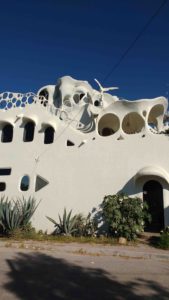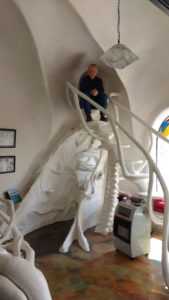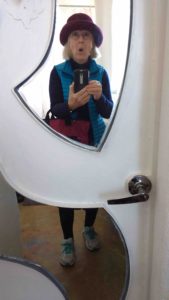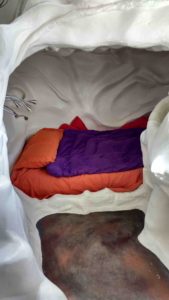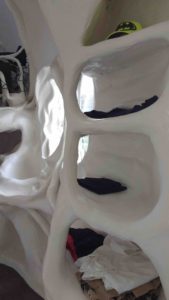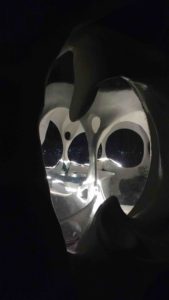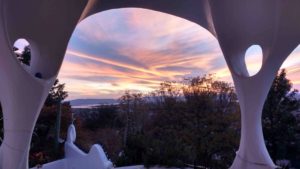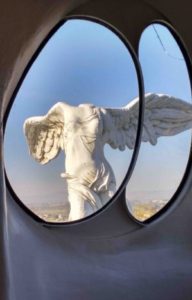Coronavirus, Mexico, The Writing Life, Travel »
Coronatravel: The Bat Casa
June 19, 2020 | Comments Off on Coronatravel: The Bat Casa | Betsy Woodman
“Wanna go to Australia?” Will asks after dinner.
“Sure,” I say, and we settle down to binge-watching A Place to Call Home. This addictive TV melodrama with its gorgeous 1950s clothes and cars is the closest we’re going to get to Sydney, at least for a while.
Otherwise, traveling these days is a matter of watching Rick Steves reruns and sorting through photographs.
There are a lot of those, especially from the last time we traveled for real. That was to San Miguel de Allende in Mexico, long symbolized by the pink sandstone towers of the parroquia. 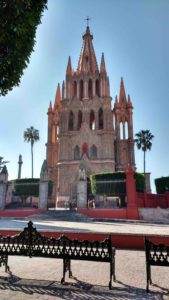 We had an extended visit there in early 2019—a few lifetimes ago.
We had an extended visit there in early 2019—a few lifetimes ago.
The town is a favorite for expatriates, many of whom live in the historic “centro,” not far from the parroquia. But we stayed not in the center but on the outskirts…in the Bat Casa.
I admit, I am a sucker for weird houses. I’d love to try life in a yurt or a converted lighthouse. Is there any wonder that the Bat Casa caught my eye online? The structure was partly inspired by the work of architect Antoni Gaudí, who put his stamp on the city of Barcelona.
Journalist Pico Iyer once said that travel was like love, “mostly because it’s a heightened state of awareness, in which we are mindful, receptive, undimmed by familiarity and ready to be transformed.”
Maybe living in the Bat Casa would be like that, too, so strange that it would shake up our brains. Psychologists talk about creating new neural pathways. That had to be a good thing, right? We booked the Bat Casa.
The house was located in the colonía of Olimpo—Mount Olympus. Not a fancy district, but it has a sweet little park and a library that looks like a cathedral. The streets are all named for Greek and Roman gods—Zeus, Diana, Ceres, Poseidon, Mercurio. The Bat Casa sat on a slope on the uphill side of the road.
On arrival, we climbed a long, steep staircase 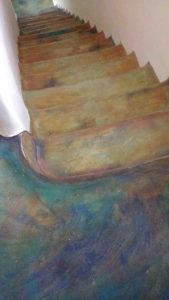 of polished concrete to the main living space and instantly experienced the hoped-for feeling of disorientation. Where were we? In a forest? A cave? Inside the skeleton of a prehistoric whale? There wasn’t a right angle to be seen.
of polished concrete to the main living space and instantly experienced the hoped-for feeling of disorientation. Where were we? In a forest? A cave? Inside the skeleton of a prehistoric whale? There wasn’t a right angle to be seen.
The ceilings of the living room and kitchen were high scalloped domes, separated by a fluted column, like a stylized tree trunk. We hung our jackets on its branches. In the living room, a staircase like a dinosaur backbone led up to a sleeping alcove under the ceiling.
No two windows in this house were identical. Some were egg-shaped, others long and curved. The mirror on the bathroom door consisted of several curved pieces that made us look like fragments of a jigsaw puzzle.
The main sleeping alcove was a little cave reached by a short winding tunnel. We stuck our belongings in crannies of various sizes and shapes.
At night, the view through to the terrace was surreal.
From the kitchen, we had wide and ever changing views. In the morning, multicolored hot air balloons rose over the landscape. At night, the lights on the distant hills twinkled against the inky darkness. The sunsets were spectacular.
Everyone seemed to know the Bat Casa. When we told cab drivers where we wanted to go, their faces lit up.
“La casa de batman! Oh! Do you own it?” “Is it really like a bat cave inside?” “You made my day!”
It’s wonderful—an unearned Brownie point in life—when you can make someone’s day just by having them drop you off in front of a funny house.
At the Bat Casa, I couldn’t complain that I didn’t have a good space to write in. Every morning I climbed this staircase to a roundish room on the roof, with a Winged Victory right outside.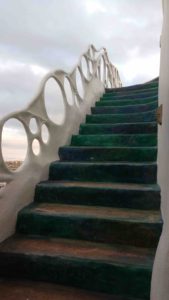
I churned out tons of words, convinced that my newly reorganized neural pathways were producing fabulous work.
Now, staying pretty close to home in spite of the partial reopening of our state, I have plenty of time for coronatraveling—looking over words churned out and photographs taken on earlier trips. Hm. Lots of editing required. And not all those photos deserve to be saved.
This pause from real traveling isn’t a bad thing. It’s a chance to absorb past trips, remember or reinvent their meaning. I’ve got several bins of photographs and diaries to process, so practically unlimited coronatraveling lies ahead.
In the meantime, to see new places like Australia, there’s all that wonderful TV.

